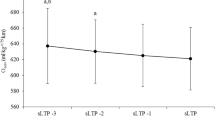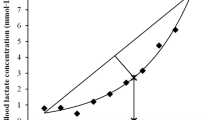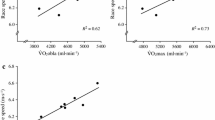Summary
The predictability of anaerobic threshold (AT) from maximal aerobic power, distance running performance, chronological age, and total running distance achieved on the treadmill (TRD) was investigated in a sample of 53 male distance runners, 17–23 years of age. The dependent variable was oxygen uptake (\(\dot V_{O_2 } \)) at which AT was detected (i. e.,\(\dot V_{O_2 } \) @AT). A regression analysis of the data indicated\(\dot V_{O_2 } \) @AT could be predicted from the following four measurements with a multipleR=0.831 and a standard error of the estimate of 2.66 ml · min−1 · kg−1:\(\dot V_{O_{2max} } \) (67.9±5.7 ml · min−1 · kg−1), 1,500-m running performance (254.5±14.2 s), TRD (6.82±1.13 km), and age (19.4±2.2 years). When independent variables were limited to\(\dot V_{O_{2max} } \) (X 1) and 1,500-m running performance (X 2) for simpler assessment, a multipleR=0.806 and a standard error of the estimate of 2.76 ml · min−1 · kg−1 were computed. A useful prediction equation with this predictive accuracy was considered to be\(\dot V_{O_2 } \) @AT= 0.386X1−0.128X2+57.11. To determine if the prediction equation developed for the 53 male distance runners could be generalized to other samples, cross-validation of the equation was tested, using 21 different distance runners, 17–22 years of age. A high correlation (R=0.927) was obtained between\(\dot V_{O_2 } \) @AT predicted from the above equation and directly measured\(\dot V_{O_2 } \) @AT. It is concluded that the generalized equation may be applicable to young distance runners for indirect assessment of\(\dot V_{O_2 } \) @AT.
Similar content being viewed by others
References
Berg K, Bell W (1980) Physiological and anthropometric determinants of mile run time. J. Sports Med 20:390–396
Conconi F, Ferrari M, Ziglio PG, Doroghetti P, Codeca L (1982) Determination of the anaerobic threshold by a non-invasive field test in runners. J Appl Physiol 52:869–873
Conley DL, Krahenbuhl GS (1980) Running economy and distance running performance of highly trained athletes. Med Sci Sports Exerc 12:357–360
Costill DL (1967) The relationship between selected physiological variables and distance running performance. J Sports Med 7:61–66
Costill DL (1972) Physiology of marathon running. JAMA 221:1024–1029
Costill DL, Branam G, Eddy D, Sparks K (1971) Determinants of marathon running success. Int Z Angew Physiol 29:249–254
Costill DL, Thomason H, Roberts E (1973) Fractional utilization of aerobic capacity during distance running. Med Sci Sports 5:248–252
Costill DL, Fink WJ, Pollock ML (1976) Muscle fiber composition and enzyme activities of elite distance runners. Med Sci Sports 8:96–100
Foster C, Costill DL, Daniels JT, Fink W (1978) Skeletal muscle enzyme activity, fiber composition and\(\dot V_{O_{2max} } \) in relation to distance running performance. Eur J Appl Physiol 39:73–80
Fox EL, Costill DL (1972) Estimated cardiorespiratory responses during marathon running. Arch Environ Health 24:317–324
Kindermann W, Sinon G, Keul J (1979) The significance of the aerobic-anaerobic transition for the determination of work load intensities during endurance training. Eur J Appl Physiol 42:25–34
Kumagai S, Tanaka K, Matsuura Y, Matsuzaka A, Hirakoba K, Asano K (1982) Relationships of the anaerobic threshold with 5 km, 10 km, and 10 mile races. Eur J Appl Physiol 49:13–23
Maron MB, Horvath SM, Wilkerson JE, Gliner JA (1976) Oxygen uptake measurements during competitive marathon running. J Appl Physiol 40:836–838
Tanaka K, Matsuura Y (1982) A multivariate analysis of the role of certain anthropometric and physiological attributes in distance running. Ann Human Biol 9:473–482
Tanaka K, Matsuura Y (1983) Physiological and anthropometric determinants of distance run performance. In: Ishiko T (ed) Physical fitness research. Baseball Magazine Sha, Tokyo, pp 273–283
Tanaka K, Matsuura Y, Kumagai S, Matsuzaka A, Hirakoba K, Asano K (1983) Relationships of anaerobic threshold and onset of blood lactate accumulation with endurance performance. Eur J Appl Physiol 52:51–56
Tanaka K, Matsuura Y, Matsuzaka A, Hirakoba K, Kumagai S, Sun-O S, Asano K (1984) A longitudinal assessment of anaerobic threshold and distance-running performance. Med Sci Sports Exercise 16:278–282
Tanaka K, Matsuura Y (1984) Marathon performance, anaerobic threshold, and onset of blood lactate accumulation. J Appl Physiol 57:640–643
Wasserman K (1984) The anaerobic threshold measurement to evaluate exercise performance. Am Rev Respir Dis 129:[Suppl] S35-S40
Weltman A, Katch V (1979) Relationship between the onset of metabolic acidosis (anaerobic threshold) and maximal oxygen uptake. J Sports Med 19:135–142
Withers RT, Sherman WM, Miller JM, Costill DL (1981) Specificity of the anaerobic threshold in endurance trained cyclists and runners. Eur J Appl Physiol 47:93–104
Yamabe H, Kobayashi K, Fujii H, Kado T, Fukuzaki H (1983) Cardiorespiratory response during exercise in effort angina pectoris. Jpn J Chest Dis 21:631–638
Author information
Authors and Affiliations
Additional information
This study was supported by grants from The Descente Foundation for the Promotion of Sports Science, awarded to K. Tanaka
Rights and permissions
About this article
Cite this article
Tanaka, K., Nakagawa, T., Hazama, T. et al. A prediction equation for indirect assessment of anaerobic threshold in male distance runners. Europ. J. Appl. Physiol. 54, 386–390 (1985). https://doi.org/10.1007/BF02337182
Accepted:
Issue Date:
DOI: https://doi.org/10.1007/BF02337182




